How to Convert Time from 24-Hour to 12-Hour
Converts time from 24-hour to 12-hour convention
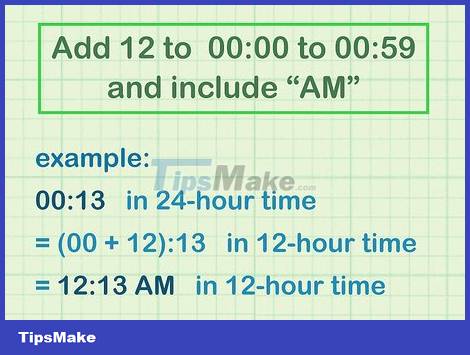
Add 12 to the first hour of the day and add 'AM' (am). For the 24-hour time convention, the midnight time displays the format 00:00. So for the midnight hour, you would add 12 and add 'AM' to convert to the 12-hour convention. That means 00:13 according to the 24-hour convention becomes 12:13 AM (am) according to the 12-hour convention.
Do you know yet?
The English abbreviations 'AM' and 'PM' have Latin roots. The word 'AM' is abbreviated from 'ante meridiem' - meaning 'before noon', and the word 'PM' is abbreviated from 'post meridiem' - meaning 'after noon'.
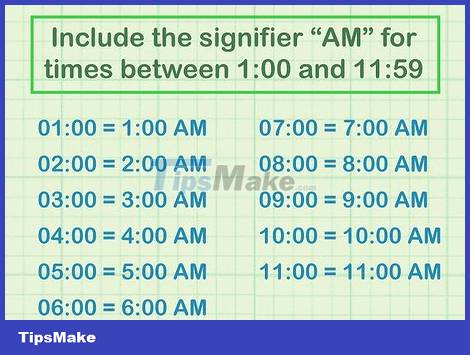
Add 'AM' (am) to the time between 1:00 and 11:59. Since the 24-hour time convention moves from 00:00 (midnight) to 1:00, you can simply add 'AM' to the time between 1:00 and 11:59. You can also omit the leading zeros. For example, 06:28 according to the 24-hour time convention is equivalent to 6:28 AM (a.m.) according to the 12-hour convention. It means:
01:00 = 1:00 AM (morning)
02:00 = 2:00 AM (morning)
03:00 = 3:00 AM (morning)
04:00 = 4:00 AM (morning)
05:00 = 5:00 AM (morning)
06:00 = 6:00 AM (morning)
07:00 = 7:00 AM (morning)
08:00 = 8:00 AM (morning)
09:00 = 9:00 AM (morning)
10:00 = 10:00 AM (morning)
11:00 = 11:00 AM (morning)
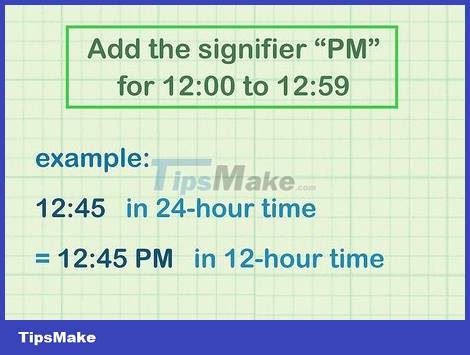
Add 'PM' (noon/afternoon/evening/night) between 12:00 and 12:59. For times after noon, simply add 'PM' after the 24-hour time to convert to 12-hour. For example, 12:45 will become 12:45 PM (noon).
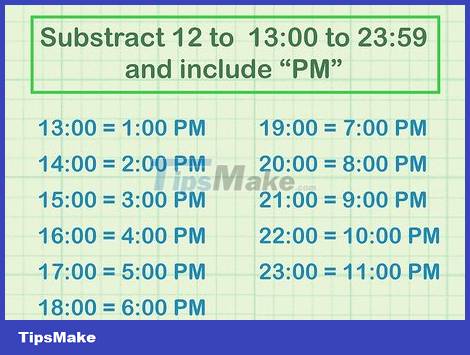
Subtract 12 for the time between 13:00 and 23:59 and add 'PM'. For times after noon, simply subtract 12 from the 24-hour time, and add 'PM' after it. For example, to convert 14:36 to 12-hour convention, you would subtract 12 from the hour, resulting in 2:36, and then add 'PM'. You do not need to add a zero before a single-digit 12-hour conventional time. Therefore:
13:00 = 1:00 PM (afternoon)
14:00 = 2:00 PM (afternoon)
15:00 = 3:00 PM (afternoon)
16:00 = 4:00 PM (afternoon)
17:00 = 5:00 PM (afternoon)
18:00 = 6:00 PM (afternoon)
19:00 = 7:00 PM (evening)
20:00 = 8:00 PM (evening)
21:00 = 9:00 PM (evening)
22:00 = 10:00 PM (night)
23:00 = 11:00 PM (night)
Convert time from 12-hour to 24-hour convention

Use 00:00 for midnight according to the 24-hour convention. Instead of using '12:00' twice as in the 12-hour convention, the 24-hour convention uses '00:00' for the hour of midnight. That means you only need to keep the minutes when converting time. For example: 12:30 AM (morning) becomes 00:30.
Do you know yet?
There is no 24:00 in the 24-hour convention because the time moves from 23:00 (11:00 midnight) to 00:00 (12:00 am).
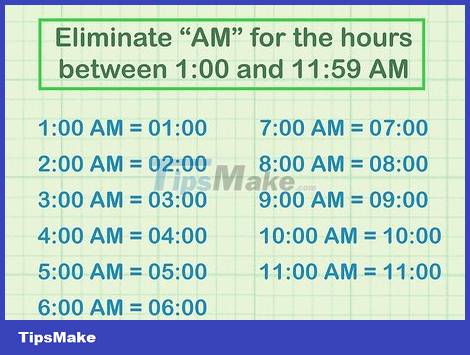
Omit 'AM' between 1:00 and 11:59 AM (am). Converting the time from midnight to noon from the 12-hour to 24-hour convention is very simple. You just need to leave out the 'AM'. If the time has a single digit, you would add a 0. For example, 6:00 AM (a.m.) becomes 6:00 a.m. and 10:15 AM (a.m.) becomes 10:15. Therefore:
1:00 AM (morning) = 01:00
2:00 AM (morning) = 02:00
3:00 AM (morning) = 03:00
4:00 AM (morning) = 04:00
5:00 AM (morning) = 05:00
6:00 AM (morning) = 06:00
7:00 AM (morning) = 07:00
8:00 AM (morning) = 08:00
9:00 AM (morning) = 09:00
10:00 AM (morning) = 10:00
11:00 AM (morning) = 11:00
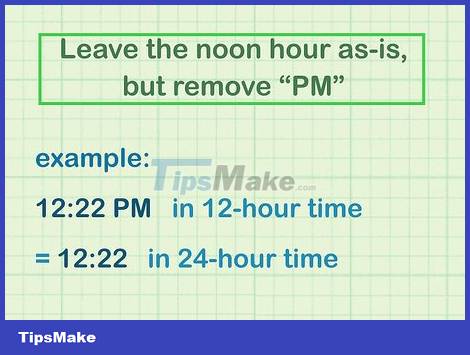
Keep the noon hour, but remove 'PM'. You just need to leave out "PM" when converting 12:00 PM (noon) to 12:00 in 24-hour format. For example, 12:22 PM (noon) becomes 12:22.
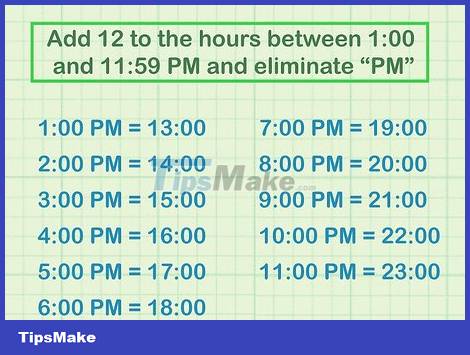
Add 12 to the time between 1:00 and 11:59 PM (night) and remove 'PM'. For afternoon, evening, and night hours, you just need to add 12 to the 12-hour conventional time to convert it to 24-hour conventional time. Also, leave out 'PM'. That means 2:57 PM becomes 2:57 PM and 11:02 PM becomes 11:02 PM. Therefore:
1:00 PM (afternoon) = 13:00
2:00 PM (afternoon) = 14:00
3:00 PM (afternoon) = 15:00
4:00 PM (afternoon) = 16:00
5:00 PM (afternoon) = 17:00
6:00 PM (afternoon) = 18:00
7:00 PM (evening) = 19:00
8:00 PM (evening) = 20:00
9:00 PM (evening) = 21:00
10:00 PM (night) = 22:00
11:00 PM (night) = 23:00
You should read it
- Things to know about golden time in photography
- HOUR function - The function returns the hour of a time value in Excel
- How to switch to 24-hour format on Android
- How to Make a Power Hour CD in iTunes
- Guide to GrabCar rental by hour
- How to Watch Less TV
- What is green time in photography? Is it different from Golden Time?
- Why 1 minute has 60 seconds, 1 hour has 60 minutes and 1 day has 24 hours?
May be interested
- How to Copy DVD Audio to MP3 with VLC Media Player
 today's tipsmake will show you how to copy (rip) dvd audio into mp3 files on windows or mac computers. you can use vlc media player to go through the process, but the final sound will often be distorted or choppy. to achieve optimal results, you should use the free program handbrake to rip dvds to mp4 files and then convert mp4 files to mp3 using vlc.
today's tipsmake will show you how to copy (rip) dvd audio into mp3 files on windows or mac computers. you can use vlc media player to go through the process, but the final sound will often be distorted or choppy. to achieve optimal results, you should use the free program handbrake to rip dvds to mp4 files and then convert mp4 files to mp3 using vlc. - How to Open a Digital Safe Without a Key
 most digital safes have mechanical locks that you can open manually instead of entering a password. but what do you do if you lose your key and the keypad has no power? do not worry! you can still open the digital safe without the key by restoring power connected to the numeric keypad to enter the password. in case you forget the password, the safe can still be reset by using a stick or small wire to press the reset button located behind the control panel on the door. if all else fails, try breaking the lock or drilling through the keyhole.
most digital safes have mechanical locks that you can open manually instead of entering a password. but what do you do if you lose your key and the keypad has no power? do not worry! you can still open the digital safe without the key by restoring power connected to the numeric keypad to enter the password. in case you forget the password, the safe can still be reset by using a stick or small wire to press the reset button located behind the control panel on the door. if all else fails, try breaking the lock or drilling through the keyhole. - The world's longest undersea power transmission cable
 the uk national grid and danish company energinet have teamed up to develop the world's longest undersea power transmission cable called viking link which will bring socio-economic benefits to both countries.
the uk national grid and danish company energinet have teamed up to develop the world's longest undersea power transmission cable called viking link which will bring socio-economic benefits to both countries. - Should I choose NanoCell or OLED TV technology?
 two of the newest types of technology are oled displays and lg's nanocell displays. these are two quite different types of tvs that are often marketed with similar features.
two of the newest types of technology are oled displays and lg's nanocell displays. these are two quite different types of tvs that are often marketed with similar features. - What is QD-OLED? Why is QD-OLED better than OLED or LCD TV?
 at ces 2022, sony announced a new flagship tv model featuring samsung's new breakthrough technology - qd-oled display.
at ces 2022, sony announced a new flagship tv model featuring samsung's new breakthrough technology - qd-oled display. - Learn about Xiaomi Smart Home
 xiaomi has created a great automation platform, allowing you to seamlessly use your phone or sensors to operate everything in your home. the following article will introduce what is included in xiaomi smart home.
xiaomi has created a great automation platform, allowing you to seamlessly use your phone or sensors to operate everything in your home. the following article will introduce what is included in xiaomi smart home.


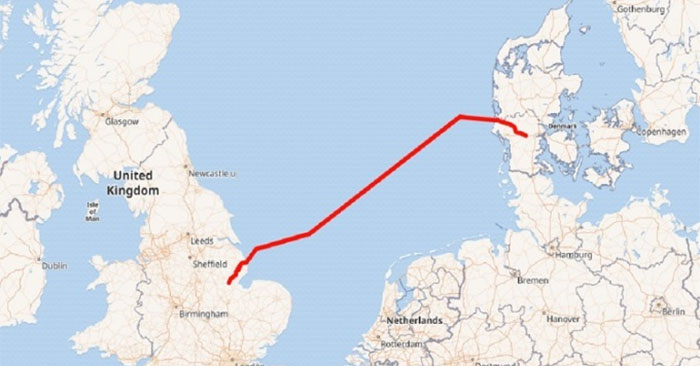



 How to switch to 24-hour format on Android
How to switch to 24-hour format on Android Things to know about golden time in photography
Things to know about golden time in photography HOUR function - The function returns the hour of a time value in Excel
HOUR function - The function returns the hour of a time value in Excel What is G hour?
What is G hour? HOUR function - The function converts a serial number into an hour in Excel
HOUR function - The function converts a serial number into an hour in Excel